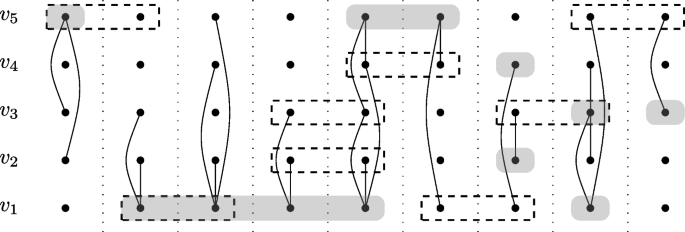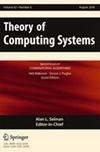解缠网络解缠的计算复杂度
IF 0.4
4区 计算机科学
Q4 COMPUTER SCIENCE, THEORY & METHODS
引用次数: 0
摘要
摘要本文研究了Rozenshtein等人提出的网络解缠问题(Data Min. knowledge)。Disc. 35(1), 213-247, 2021),它是时间图(其边缘集在离散时间步长上变化的图)上的顶点覆盖的一种变体。它们引入了两个问题变体。目标是为每个顶点选择最多k个时间间隔,以便覆盖所有时间边,并且(取决于问题的变体)最小化最大间隔长度或间隔长度的总和。这个问题有数据挖掘应用在寻找解释复杂网络中实体相互作用的活动时间轴上。这个问题的两个变体都是np困难的。在本文中,我们开始了一个多元复杂性分析,涉及以下参数:顶点数,时间图的生存期,每个顶点的区间数和区间长度界。对于这两个问题版本,我们(几乎)完全解决了这四个参数的所有组合的参数化复杂性,从而划定了固定参数可跟踪性的边界。本文章由计算机程序翻译,如有差异,请以英文原文为准。

Disentangling the Computational Complexity of Network Untangling
Abstract We study the network untangling problem introduced by Rozenshtein et al. (Data Min. Knowl. Disc. 35(1), 213–247, 2021), which is a variant of Vertex Cover on temporal graphs–graphs whose edge set changes over discrete time steps. They introduce two problem variants. The goal is to select at most k time intervals for each vertex such that all time-edges are covered and (depending on the problem variant) either the maximum interval length or the total sum of interval lengths is minimized. This problem has data mining applications in finding activity timelines that explain the interactions of entities in complex networks. Both variants of the problem are NP-hard. In this paper, we initiate a multivariate complexity analysis involving the following parameters: number of vertices, lifetime of the temporal graph, number of intervals per vertex, and the interval length bound. For both problem versions, we (almost) completely settle the parameterized complexity for all combinations of those four parameters, thereby delineating the border of fixed-parameter tractability.
求助全文
通过发布文献求助,成功后即可免费获取论文全文。
去求助
来源期刊

Theory of Computing Systems
工程技术-计算机:理论方法
CiteScore
1.90
自引率
0.00%
发文量
36
审稿时长
6-12 weeks
期刊介绍:
TOCS is devoted to publishing original research from all areas of theoretical computer science, ranging from foundational areas such as computational complexity, to fundamental areas such as algorithms and data structures, to focused areas such as parallel and distributed algorithms and architectures.
 求助内容:
求助内容: 应助结果提醒方式:
应助结果提醒方式:


